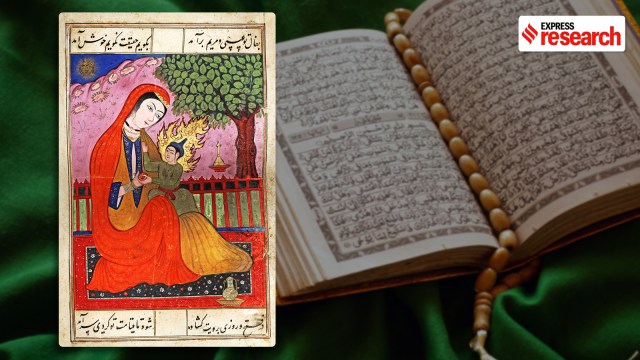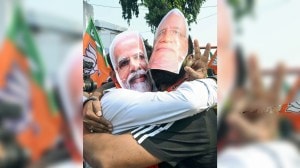The story of Jesus being born to Mary in a barn in Bethlehem, surrounded by shepherds, animals and angels, is the gospel truth that gave rise to Christianity, the largest religion in the world. However, it is often forgotten that this same narrative, albeit in a modified form, is presented in yet another widely popular religious text, the Quran.
The holy book of Islam refers to several Biblical characters, including Jesus, Mary, and the angel Gabriel. Other characters such as Abraham, Moses and Adam are also present in the Quranic narrative. Interestingly, Mohamed Khaled Sayed, a scholar of religious history, says in a 2023 article that Jesus, known as Isa in Arabic, is mentioned five times more than the Prophet himself in the Quran.
Mary, or Maryam on the other hand, happens to be the only woman mentioned by name in the Quran. She has an entire chapter, Surah 19, dedicated to her and her history. In his book What Everyone Needs to Know about Islam, Professor John Esposito writes, “Mary is mentioned more times in the Quran than the entire New Testament, and more biographical information about her is contained in the Quran than in the New Testament.”
References to the Biblical characters are not just limited to the Quran but spread across the entire Arabic Islamic literary tradition of the premodern period, and say much about the exchanges both religious traditions had in their earliest days.
The Islamic image of Jesus first took place in the Quran and spread to other scriptures of the Muslim gospel. In his book The Muslim Jesus (2001), Palestinian historian Tarif Khalidi discusses in detail the background in which Jesus came to be incorporated in the Quran. “Islam was born in a time and place where the figure of Jesus was widely known,” he says.
As has been made evident from sources such as pre-Islamic Arabic poetry or newly discovered early Islamic material, diverse Christian communities existed in Arabia or nearby areas and they had been circulating rich and diverse images of Jesus.
It must be noted that Islam arrived when the ecumenical councils were yet to be concluded. The seven councils that took place in the region of modern-day Turkey, between the fourth and the eighth centuries CE, are known to have established a unified Christendom among the multiple strands of pre-modern Christianity. “In other words, Islam was born amid many, often mutually hostile Christian communities and not in the bosom of a universal church,” writes Khalidi. Apart from that, a diverse amalgamation of religious tradition, lore, and scriptures related to Judaism existed in the pre-Islamic Arabic world.
Story continues below this ad
Quite understandably, the reverence towards Jesus, being widely popular in this region, must have entered Quranic vocabulary. The Quran contains many references to stories and figures in the Old and New Testaments, including Adam and Eve, Abraham and Moses, and Jesus and Mary.
Scholars, however, have long debated the precise origins of the image of Jesus as presented in the Quran. Khalidi in his book, writes that in the early 20th century, for instance, there emerged a strand of analysis which suggested that Muhammad had a confused or heretical notion of Christianity. “The Qur’anic stories and sayings of Jesus which “he” narrated were fables and fantasies, or at best apocryphal material which, one is left to presume, circulated more easily in the marginal regions of the Byzantine world,” write Khalidi.
More recent research, however, has radically altered our understanding of early Christian texts and sectarian beliefs. Consequently, a better understanding of Eastern Christianity has been developed, which happens to form the immediate background to the depiction of Jesus in the Quran. Eastern Christianity refers to the schools of Christian traditions that developed in the Eastern Mediterranean region and is far distinguished from those formed under the Latin Church and is followed by the majority of Christians around the world.
Further, this new research has also shown that many of the traditions and writings of Eastern Christianity were not incorporated in the New Testament by the church councils of the fourth and fifth centuries. However, we do find them represented in the Quran.
Story continues below this ad
Biblical traditions in the Quran
The Quranic account of Mary includes the story of her mother Anna’s pregnancy, Mary’s birth, the annunciations of the birth of John the Baptist and Jesus as well as the affirmation of the virgin conception and birthing of Jesus. The Quran also records some of Jesus’s miracles, such as giving sight to the blind, healing lepers, raising the dead, and breathing life into clay birds.
The Biblical nativity scene is narrated in detail in the chapter on Maryam in the Quran:
And mention in the Book ˹O Prophet, the story of˺ Mary when she withdrew from her family to a place in the east,
screening herself off from them. Then We sent to her Our angel, ˹Gabriel,˺ appearing before her as a man, perfectly formed.
She appealed, “I truly seek refuge in the Most Compassionate from you! ˹So leave me alone˺ if you are God-fearing.”
Story continues below this ad
He responded, “I am only a messenger from your Lord, ˹sent˺ to bless you with a pure son.”
She wondered, “How can I have a son when no man has ever touched me, nor am I unchaste?”
He replied, “So will it be! Your Lord says, ‘It is easy for Me. And so will We make him a sign for humanity and a mercy from Us.’ It is a matter ˹already˺ decreed.”
So she conceived him and withdrew with him to a remote place. (Quran 19: 16-22)
Story continues below this ad
It is important to note that while the Nativity scene clearly draws parallels from the Biblical account, it also differs in some ways. The Quranic Jesus is not born in Bethlehem but rather in an unspecified “remote place”. Moreover, Mary is alone here, unaccompanied by Joseph or anyone else, and delivers Jesus under a palm tree. The Turkish writer Mustafa Akyol, in an article for New Lines Magazine, explains that the Quranic description of the birth of Jesus is, in fact, taken from two ancient Christian texts that did not end up in the New Testament. The first among these is the Protoevangelium of James, a second-century Christian text popular among Eastern Christians. The other is the Gospel of Pseudo-Matthew, which draws heavily from the Protoevangelium.
Yet another important aspect of the Quranic description of Jesus’ birth is the announcement the infant makes to those around him:
Jesus declared, “I am truly a servant of Allah. He has destined me to be given the Scripture and to be a prophet.
He has made me a blessing wherever I go, and bid me to establish prayer and give alms-tax as long as I live,
and to be kind to my mother. He has not made me arrogant or defiant.
Story continues below this ad
Peace be upon me the day I was born, the day I die, and the day I will be raised back to life!”
That is Jesus, son of Mary. ˹And this is˺ a word of truth, about which they dispute. (Quran 19: 30-34)
The Quran differed from the Biblical account of Jesus in two important accounts. First, although the Quran confirmed the virgin conception of Jesus, it did not believe Jesus to be divine or to be the son of God. Rather, as noted by Esposito in his book, in Muslim theology, Jesus is “one of the long line of righteous prophets and second only to Muhammad in importance.” Secondly, Esposito mentions, “Muslims do not believe in the crucifixion and resurrection of Jesus, instead God took Jesus to himself.”
Despite the minor distinctions, the astounding parallels between the two scriptures are a reminder of the history of co-existence and mutual interactions that predated the birth of modern religions.
Story continues below this ad
Further readings:
John L. Esposito; What Everyone Needs to Know about Islam; Oxford University Press; 2011
Tarif Khalidi; The Muslim Jesus: Sayings and Stories in Islamic Literature; Harvard University Press; 2003
Mustafa Akyol; Jesus’ Birth Betwen Islam and Christianity; New Lines Magazine; 2022

































